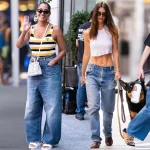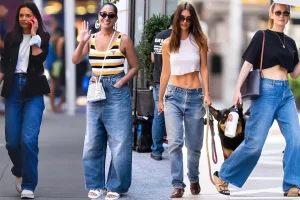From the moment it was announced, the Metropolitan Museum of Art’s spotlight-grabbing exhibition “Karl Lagerfeld: Line of Beauty” has been the subject of criticism. While many have heaped praise on the designer and the indisputable mark he made on fashion, particularly during his tenure at Chanel, others scorned the decision to give the ultimate museum treatment to a “known bigot,” as the British actress and activist Jameela Jamil described Lagerfeld to her nearly 4 million followers on Instagram.
During the 2010s, the last decade of his life and an era when social and political awareness increasingly infiltrated the world of fashion, Lagerfeld failed to get with the times. In different contexts, the notorious provocateur repeatedly made comments against body positivity, immigrants and refugees, and the #MeToo movement. Among his most infamous remarks: “No one wants to see curvy women” and “If you don’t want your pants pulled about, don’t become a model.”
None of Lagerfeld’s many wrongdoings figure in the Met exhibition, however. Instead, the show—which runs through July 16—emphasizes the designer’s singular process and innovative techniques, as well as the myriad historical and artistic references and personal collecting practices that informed his designs. While Lagerfeld’s caricature-like persona and humor are explored in wall texts and the garments themselves, the consequences of his flippant attitude are not, with the exception of a discreet mention in the exhibition catalogue. A clear choice was made to isolate Lagerfeld-the-creative-genius from Lagerfeld-the-deeply-flawed-person.
That choice has proven problematic to some observers, including Alexandra Schwartz, curator of modern and contemporary art, craft, and design at New York’s Museum of Arts and Design (MAD). “Lagerfeld was such a giant that to pretend he wasn’t would be like throwing the baby out with the bathwater. There’s a lot of innovation and creativity there,” Schwartz said. “But no one gains by pretending that problematic dynamics don’t exist, because they always do. And it’s not just Lagerfeld.”
Schwartz, who has curated shows about feminism, gendered perspectives, and power such as “52 Artists: A Feminist Milestone” at the Aldrich Contemporary Art Museum (2022–23) and “Modern Women: Single Channel” at MoMA PS1 (2011), continued: “If you’re working with figures like this, institutions have a responsibility to acknowledge the positive and negative aspects of an artist’s work. They’re part of the story.”
Matthew Yokobosky, senior curator of fashion and material culture at the Brooklyn Museum, called the idea of presenting “art as just an object, devoid of the artist” a “mid-20th-century approach” in need of updating. “I find that personal information about the designer so often plays into what they’ve designed that it’s really hard to make a separation between the two,” Yokobosky said. “That’s not to say you can’t just admire the work, but it becomes more interesting to talk and think about when you know something about the artist.”

In addition to integrating more biographical information into fashion exhibitions, the 21st-century approach encourages making shows relevant to today’s evolving culture while providing an answer to the question: “Why should we care?”
“It’s certainly possible to just show the work, but sometimes we find that people demand more,” said Valerie Steele, director of the Museum at the Fashion Institute of Technology (FIT) in New York. Steele cited a new generation of FIT curators for their eagerness to address topics such as sustainability and representation. Associate Curator Elizabeth Way, for example, conceived the award-winning 2016-17 exhibition “Black Fashion Designers,” which amplified the work of 60 talents, many of whom were sorely overlooked, while challenging the notion that they work in a single “Black style.”
“We tend not to do many shows about a single designer because they tend to be very hagiographic,” said Steele, who noted that exceptions at the Museum at FIT include shows on lesser-known designers such Isabel Toledo and Ralph Rucci. Steele also pointed out that these designers did not sponsor their exhibitions, as is common with major brand blockbusters like “A Line of Beauty,” which received support from Chanel, Fendi, and Karl Lagerfeld the label. Such commercial relationships are often viewed skeptically for the ways they can potentially skew objective storytelling to present brands in their best light. “We try to do exhibitions that somehow advance knowledge about fashion, and it is easier to do with thematic shows so that you could put designers in context.”

Beyond its well-known monographic masterworks like 2011’s “Alexander McQueen: Savage Beauty” and 2014’s “Charles James: Beyond Fashion,” the Met has become an undeniable leader in avant-garde thematic shows, largely ushered by Andrew Bolton, curator of the museum’s Costume Institute. Since assuming his position in 2015, Bolton—who declined to comment on the Lagerfeld show for this story—has brought an intellectual edge to many of the Met’s fashion shows, opting for abstract, conceptual themes and formats. A prime example is the two-part exhibition “In America: A Lexicon of Fashion” (2021-22) and “In America: An Anthology of Fashion” (2022). Conceived like a patchwork quilt of looks that have reflected America’s defining emotional qualities (nostalgia, strength, belonging, etc.), “Lexicon” placed emphasis on cutting-edge contemporary designers to convey the country’s diverse sartorial identity. American mainstays such as Ralph Lauren, Michael Kors, and Marc Jacobs were shown alongside Native American Jamie Okuma, Mexican-American Willy Chavarria, and South Korean-born Ji Won Choi.
To identify the emergence of American style and chart the fashion industry’s development, “Anthology” featured narrative vignettes throughout the period rooms of the Met’s American Wing. The show sought to acknowledge the complex histories of the interiors, some of which were originally built for slave and plantation owners, while also presenting a more layered look at the history of fashion. Designers such as Ann Lowe, an African-American woman who created Jackie Kennedy’s iconic wedding dress and was considered “society’s best-kept secret,” were brought to the fore.

The fact that the Met’s Lagerfeld exhibition came just one year after this powerful duo of shows —and in the midst of the museum’s broader revisioning of its collection to be more inclusive and ethically responsible—makes the lack of acknowledgement of the designer’s regressive attitudes all the more glaring. The Lagerfeld show’s organization is certainly original: like the Met’s 2019 show “Camp: Notes on Fashion,” which took cues from a Susan Sontag essay, the structure and content of the Lagerfeld exhibition found inspiration from a literary source — in this case William Hogarth’s 1753 The Analysis of Beauty. But marking a departure from other recent Met shows, truthful storytelling seems to have been passed over in the service of beauty and entertainment.
The final portion of the exhibition examines Lagerfeld’s satirical side, in which his caricature-like image is seen on garments and accessories from his eponymous label. Near this display is the exhibition’s most peculiar intervention — an “echo chamber,” as Bolton described it in a virtual tour, displaying dozens of iPhones featuring video of Lagerfeld hysterically laughing during a candid moment on set, interspliced with some of his more PG-rated quotes. The choice to include so-called Karlisms—among them “You have to do things that one is not supposed to do,” “I have no human feelings,” and “I like being politically incorrect … because I can’t put up with political correctness”—seems to cheekily allude to the designer’s loose lips. Similarly, the exhibition’s catalogue refers to Lagerfeld’s “sometimes fearsome words” but offers no further detail. By not addressing how Lagerfeld’s outspokenness repeatedly escalated into targeted, bigoted statements, the exhibition undermines the severity of Lagerfeld’s rhetoric.

“You have to make a decision as a curator whether you’re going to support a designer’s creative talents and whether you’re going to be comfortable explaining if they’ve done something that was in poor taste,” said Yokobosky, who recalled being similarly confronted when curating the Brooklyn Museum’s 2021-22 iteration of “Christian Dior: Designer of Dreams,” a traveling retrospective organized with the French fashion house to celebrate its 70th anniversary. “At the Brooklyn Museum, we don’t like to shy away from a controversial topic,” Yokobosky said, noting the museum’s current show “It’s Pablo-matic: Picasso According to Hannah Gadsby.” “When we agreed that we were going to do Dior, we immediately had a conversation about how we would talk about John Galliano.”
The exhibition chronicled Christian Dior and each of the six creative directors who succeeded him, including Gibraltar-born British designer Galliano, who worked at the house from 1997 to 2011. Galliano’s odious behavior was succinctly but directly addressed in his section’s introductory text, which also illustrated the necessity of providing context around a punchy quote. It read: “In 1999 and 2000, Galliano’s collections known as Matrix and Les Clochards marked the turn toward an even more extravagant style. He answered those who looked askance at the latter collection’s apparent glorification of the clothing creations worn by people experiencing homelessness by claiming that he had been inspired by the Tramp, Charlie Chaplin’s most famous screen character. When questioned about his excesses, he replied, ‘I prefer bad taste to no taste.’ Galliano left Dior in 2011, embroiled in a scandal after making anti-Semitic comments. Nevertheless, his years at Dior’s artistic director represented an era of unparalleled creative excess.”

As to how much the designer’s behavior continues to affect his present status, Yokobosky said, “Galliano addressed his controversy as many times and in the most direct way as he could. Galliano is not canceled. People show his work. But if he hadn’t had such a horrifying incident, would he have had a retrospective by now? Probably.”
The same may be said about Dolce & Gabbana, whose racist advertising — most notoriously featuring an image of a Chinese model clumsily eating spaghetti with chopsticks — is one of several offenses also including the designers’ disdainful language about in vitro fertilization, surrogacy, and adoption by same-sex couples. Yokobosky has never shown Dolce & Gabbana at the Brooklyn Museum, and said, if a particular exhibition’s context called for it, he would “probably have a longer thought process about whether to include them.” Thinking out loud, he said, “If I was doing a show on Madonna, would I include Dolce & Gabbana’s costumes for ‘The Girlie Show’ tour? Or, if it was a show on Susan Sarandon, would I include the Dolce & Gabbana gown she wore when she accepted her Academy Award?”
Steele said she encourages truthful, matter-of-fact storytelling: “Fashion often goes into hyperbole. If you look up ‘Coco Chanel’ online, you either find ‘Chanel, liberator of women, genius, invented this and this’ or ‘Chanel, Nazi spy.’ It’s very rare that you have a nuanced perspective.”

In the traveling exhibition “Gabrielle Chanel. Fashion Manifesto,” supported by Chanel, two of the world’s preeminent fashion institutions have taken different approaches. The show originated in 2021 at the Palais Galliera in Paris and, like the Lagerfeld show, garnered criticism for focusing exclusively on the designer’s creative output. “They wanted to talk about Chanel as a designer, which is one of the only things that you can show in an exhibition of clothes,” said Steele, adding that catalogue text and exhibition symposiums can also be forums for presenting additional information about designers. “It’s trickier to figure out a way to use the work to make an in-depth interpretation of the life.” (In a timeline at the end of its exhibition catalogue, the Palais Galliera did include mention of the designer’s 1944 arrest for her relationship with a German officer.)
This September, London’s Victoria & Albert Museum will present the Chanel exhibition with a more holistic approach. A spokesperson for the museum told ARTnews: “We won’t shy away from discussing the more controversial aspects of Chanel’s history, including her actions during the Second World War. The exhibition includes a section called ‘Closing the House,’ which will outline the impact of the outbreak of war in 1939 on her personal and professional life.”

In the future, will museums follow clear ethical codes and policies to expand how they engage contentious fashion designers? “A lot of times, people assume that if a designer is featured in a museum it’s because you want to exalt and celebrate them,” said Steele, who pointed to the art world as an area that offers examples of more-nuanced engagement. She recalled her experience visiting “Philip Guston Now” at the National Gallery of Art in Washington D.C., an iteration of a traveling show that was postponed in 2020 over concern about Guston’s provocative, racism-confronting paintings of figures adorned in the masks and robes of the Ku Klux Klan. “The exhibition wasn’t a celebration, nor was it an interrogation,” said Steele. Instead, its even-handed approach to a complex subject, she said, could encourage fashion curators to explore the vast middle ground between “canceling designers and praising them to the sky.”
Source : Art News




























